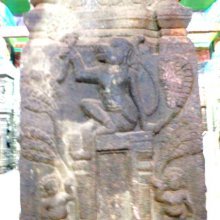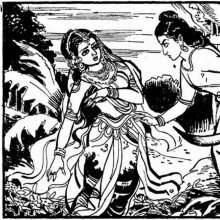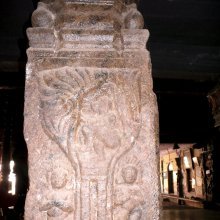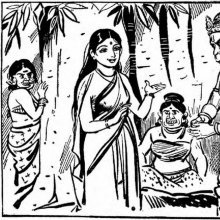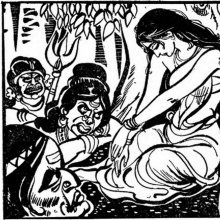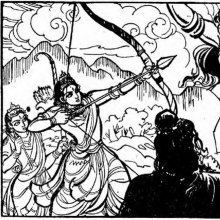Rakshasi, Rakṣasī, Rākṣasī, Rākṣasin, Rakshashi, Rakshashin: 17 definitions
Introduction:
Rakshasi means something in Buddhism, Pali, Hinduism, Sanskrit, Jainism, Prakrit, Marathi, Hindi. If you want to know the exact meaning, history, etymology or English translation of this term then check out the descriptions on this page. Add your comment or reference to a book if you want to contribute to this summary article.
The Sanskrit terms Rakṣasī and Rākṣasī and Rākṣasin can be transliterated into English as Raksasi or Rakshasi or Raksasin or Rakshasin, using the IAST transliteration scheme (?).
Images (photo gallery)
(+1 more images available)
In Hinduism
Shaivism (Shaiva philosophy)
Source: Wisdom Library: Kubjikāmata-tantraRākṣasī (राक्षसी):—Fourth of the eight Mātṛs born from the body of Khecarī, according to the Kubjikāmatatantra. These eight sub-manifestations (mātṛ), including Rākṣasī, represent the eight directions of the compass (from east to north-east) and are presided over by the Bhairava Saṃvarta and his consort Rudrāṇī. Khecarī is the first of the Eight Mahāmātṛs, residing within the Mātṛcakra (third of the five cakras) and represents the element ether or space.

Shaiva (शैव, śaiva) or Shaivism (śaivism) represents a tradition of Hinduism worshiping Shiva as the supreme being. Closely related to Shaktism, Shaiva literature includes a range of scriptures, including Tantras, while the root of this tradition may be traced back to the ancient Vedas.
Purana and Itihasa (epic history)
Source: Wisdom Library: The Matsya-purāṇaRākṣasī (राक्षसी) is the name of a mind-born ‘divine mother’ (mātṛ), created for the purpose of drinking the blood of the Andhaka demons, according to the Matsya-purāṇa 179.8. The Andhaka demons spawned out of every drop of blood spilled from the original Andhakāsura (Andhaka-demon). According to the Matsya-purāṇa 179.35, “Most terrible they (e.g., Rākṣasī) all drank the blood of those Andhakas and become exceedingly satiated.”
The Matsyapurāṇa is categorised as a Mahāpurāṇa, and was originally composed of 20,000 metrical verses, dating from the 1st-millennium BCE. The narrator is Matsya, one of the ten major avatars of Viṣṇu.
Source: Cologne Digital Sanskrit Dictionaries: The Purana IndexRākṣasī (राक्षसी).—A mind-born mother.*
- * Matsya-purāṇa 179. 16.

The Purana (पुराण, purāṇas) refers to Sanskrit literature preserving ancient India’s vast cultural history, including historical legends, religious ceremonies, various arts and sciences. The eighteen mahapuranas total over 400,000 shlokas (metrical couplets) and date to at least several centuries BCE.
Shaktism (Shakta philosophy)
Source: Google Books: ManthanabhairavatantramRākṣasī (राक्षसी) refers to one of the eight Yoginīs (yoginī-aṣṭaka) associated with Tisrapīṭha (located in the ‘end of sound’—nādānta), according to the Manthānabhairavatantra, a vast sprawling work that belongs to a corpus of Tantric texts concerned with the worship of the goddess Kubjikā.—[...] The eight Yoginīs (yoginyaṣṭaka): Rākṣasī, Ghoraraktākṣī, Viśvarūpī, Bhayaṃkarī, Dhvāṃkṣī, Raudravetālī, Śuṣkāṅgī, Narabhojanī
Source: Kamakoti Mandali: The Yoginis of Narasimha VyuhaRākṣasī (राक्षसी) is the name of a Mātṛkā-Śakti created by Mahārudra in order to control the plague of demons created by Andhakāsura.—Accordingly, Andhaka-Asura tried to kidnap Umā (Devī Pārvatī), and was fiercely attacked by Mahārudra who shot arrows at him from his mahāpināka. when the arrows pierced the body of Andhakāsura, drops of blood fell to earth and from those drops, thousands of Andhakas arose. To control this plague of demons, Mahārudra created Mātṛkā-Śaktis [viz., Rākṣasī] and ordered them to drink the blood of the demons and drain them dry.
Source: Kamakoti Mandali: Nrisimha matrika-mandalaRākṣasī (राक्षसी) refers to one of the various Mātṛkā-Śaktis created by Rudra in order to destroy the clones that spawned from Andhaka’s body.—Accordingly, [...] Andhakāsura attempted to abduct Girājanandinī (Pārvatī) and thus ensued a fierce battle between Andhakāsura and the great Rudra, the Lord of Umā. Like raktabīja, every drop of blood that fell from the body of Andhaka created another Asura like him and in no time, the entire world was filled with Andhakas. To destroy the growing number of Andhakas, Rudra created innumerable Mātṛkā-Śaktis [viz., Rākṣasī]. These Śaktis of immense power at once began to drink every drop of blood that flowed from the body of Andhaka, but they could still not effectively contain the emergence of more and more demons.

Shakta (शाक्त, śākta) or Shaktism (śāktism) represents a tradition of Hinduism where the Goddess (Devi) is revered and worshipped. Shakta literature includes a range of scriptures, including various Agamas and Tantras, although its roots may be traced back to the Vedas.
In Buddhism
Tibetan Buddhism (Vajrayana or tantric Buddhism)
Source: Wisdom Library: Tibetan BuddhismRākṣasī (राक्षसी) refers to a group of deities mentioned as attending the teachings in the 6th century Mañjuśrīmūlakalpa: one of the largest Kriyā Tantras devoted to Mañjuśrī (the Bodhisattva of wisdom) representing an encyclopedia of knowledge primarily concerned with ritualistic elements in Buddhism. The teachings in this text originate from Mañjuśrī and were taught to and by Buddha Śākyamuni in the presence of a large audience (including the Rākṣasīs).
Source: Google Books: An Esoteric Exposition of the Bardo Thodol Part ARakṣasī (रक्षसी):—One of the six ‘Queens of Yoga’ projecting the rites of enrichment—The blackish tiger-headed Rakṣasī, (meaning a ‘cannibal demon’) drinking from a kapāla guards the southern petal. Rakṣasī directs the most refined manasic attributes of this piṅgalā line to be integrated with the pranas of the Base of Spine and Sacral centres.
The tiger represents the saṃskāras of strong passions that are well hidden in the jungles of desires, and which can spring out at any moment to overwhelm the individual. Such passions are eventually transformed into the ambrosial bodhicitta contained in the skull cup, signifying the mastery of all aspects of human relationships and sexual union. The (kundalinī) potency veiled by the Base of Spine centre will then be conveyed into the entire Earthy circulation of the Gonad centres. Until then the cup contains the intoxicating liquor of infatuation with the pleasure of the gratifications of the form and loving relationships, which the tiger stalks at first. Later he yogically seeks out the inner Fire of the psychic heat.
Source: academia.edu: The Structure and Meanings of the Heruka MaṇḍalaRākṣasī (राक्षसी) refers to one of the female world-guardians (lokapālinī) of the Medinīcakra, according to the 10th century Ḍākārṇava chapter 15. Accordingly, the medinīcakra refers to one of the three divisions of the dharma-puṭa (‘dharma layer’), situated in the Herukamaṇḍala. Rākṣasī is associated with the charnel ground (śmaśāna) named Mūkana; with the tree (vṛkṣa) named Bijjora; with a female serpent (nāginī) and with a female cloud (meghinī).

Tibetan Buddhism includes schools such as Nyingma, Kadampa, Kagyu and Gelug. Their primary canon of literature is divided in two broad categories: The Kangyur, which consists of Buddha’s words, and the Tengyur, which includes commentaries from various sources. Esotericism and tantra techniques (vajrayāna) are collected indepently.
In Jainism
General definition (in Jainism)
Source: archive.org: TrisastisalakapurusacaritraRākṣasī (राक्षसी) is the name of a vidyā, according to the Jain Ramayana and chapter 7.1 [origin of the rākṣasavaṃśa and vānaravaṃśa] of Hemacandra’s 11th century Triṣaṣṭiśalākāpuruṣacaritra: an ancient Sanskrit epic poem narrating the history and legends of sixty-three illustrious persons in Jainism.
Accordingly, as Kaikasī said to her sons: “[...] Bhīma, the lord of Rākṣasas, gave Laṅkā and Rākṣasadvīpa with Pātālalaṅkā and the vidyā called ‘Rākṣasī’ to King Meghavāhana, the first bulb of the Rakṣovaṃśa, his son in a former birth, for revenge on enemies. As their ancestral capital has been seized by enemies, your father and paternal grandfather stay here like dead men. [...]”.

Jainism is an Indian religion of Dharma whose doctrine revolves around harmlessness (ahimsa) towards every living being. The two major branches (Digambara and Svetambara) of Jainism stimulate self-control (or, shramana, ‘self-reliance’) and spiritual development through a path of peace for the soul to progess to the ultimate goal.
Languages of India and abroad
Marathi-English dictionary
Source: DDSA: The Molesworth Marathi and English Dictionaryrākṣaśī (राक्षशी).—f & a Properly rākṣasī.
--- OR ---
rākṣasī (राक्षसी).—f (S) pop. rākṣasīṇa f A female rākṣasa. rākṣasaṇī pīṭha kāṇḍitāta gharāmadhyēṃ -rānāmadhyēṃ -tēthēṃ A phrase expressive of extreme desolation. Is. xiii. 21.
--- OR ---
rākṣasī (राक्षसी).—a (rākṣasa) Relating to a Rakshas. 2 fig. Outrageous, atrocious, daring, desperate--actions: violent, harsh, rough--remedies: gross, unseemly, enormous--food, eating; forming such compounds as rākṣasī kṛtya-karaṇī-khāṇēṃ-bhāṣaṇa-ghōḍā-bāga- mañjala-jōra and others in order.
Source: DDSA: The Aryabhusan school dictionary, Marathi-Englishrākṣasī (राक्षसी).—a Relating to a rākṣasa. Outrage ous; daring; violent.
--- OR ---
rākṣasī (राक्षसी).—f A female rākṣasa.
Marathi is an Indo-European language having over 70 million native speakers people in (predominantly) Maharashtra India. Marathi, like many other Indo-Aryan languages, evolved from early forms of Prakrit, which itself is a subset of Sanskrit, one of the most ancient languages of the world.
Sanskrit dictionary
Source: Cologne Digital Sanskrit Dictionaries: Monier-Williams Sanskrit-English Dictionary1) Rākṣasī (राक्षसी):—[from rākṣasa] a f. a Rākṣasī or female demon, [Mahābhārata; Kāvya literature; Kathāsaritsāgara]
2) [v.s. ...] the island of the Rākṣasas, id est. Laṅkā or Ceylon, [Buddhist literature]
3) [v.s. ...] Name of a malignant spirit supposed to haunt the four corners of a house, [Varāha-mihira’s Bṛhat-saṃhitā]
4) [v.s. ...] of a Yoginī, [Hemādri’s Caturvarga-cintāmaṇi]
5) [v.s. ...] night, [cf. Lexicographers, esp. such as amarasiṃha, halāyudha, hemacandra, etc.]
6) [v.s. ...] a kind of plant (= caṇḍā), [cf. Lexicographers, esp. such as amarasiṃha, halāyudha, hemacandra, etc.]
7) [v.s. ...] a large tooth, tusk, [cf. Lexicographers, esp. such as amarasiṃha, halāyudha, hemacandra, etc.]
8) [from rākṣasa] b in [compound] for rākṣasa.
Source: DDSA: Paia-sadda-mahannavo; a comprehensive Prakrit Hindi dictionary (S)Rākṣasī (राक्षसी) in the Sanskrit language is related to the Prakrit word: Rakkhasī.
[Sanskrit to German]
Sanskrit, also spelled संस्कृतम् (saṃskṛtam), is an ancient language of India commonly seen as the grandmother of the Indo-European language family (even English!). Closely allied with Prakrit and Pali, Sanskrit is more exhaustive in both grammar and terms and has the most extensive collection of literature in the world, greatly surpassing its sister-languages Greek and Latin.
Hindi dictionary
Source: DDSA: A practical Hindi-English dictionaryRākṣasī (राक्षसी):—(nf) an ogress; monstress; (a) monstrous, demonic; —[sāyā] demonic conjuration.
...
Kannada-English dictionary
Source: Alar: Kannada-English corpusRākṣasi (ರಾಕ್ಷಸಿ):—
1) [noun] a female giant, demon.
2) [noun] (fig.) an extremely cruel, wicked woman.
3) [noun] the plant Pavonia odorata of Malvaceae family; fragrant sticky mallow.
Kannada is a Dravidian language (as opposed to the Indo-European language family) mainly spoken in the southwestern region of India.
See also (Relevant definitions)
Starts with (+6): Rakshasi Avatara, Rakshasi Bhasha, Rakshasi Daulata, Rakshasi Dhanya, Rakshasi Hada, Rakshasi Jhompa, Rakshasi Maya, Rakshasi Muluka, Rakshasi Pika, Rakshasi Sampatti, Rakshasi Upaya, Rakshasi Vela, Rakshasi Vidya, Rakshasi-hada, Rakshasi-upaya, Rakshasi-vivaha, Rakshasibhu, Rakshasibhuta, Rakshasidvipa, Rakshasikarana.
Ends with: Amarakshasi, Apetarakshasi, Apretarakshasi, Balarakshasi, Brahmarakshasi, Jalarakshasi, Manurakshasi, Manusharakshasi, Nararakshasi, Paparakshasi, Pretarakshasi, Rajanirakshasi.
Full-text (+258): Holika, Malakutadanti, Ghatotkaca, Jambhala, Pushpotkata, Rajanirakshasi, Ajihvika, Dundha, Tadaka, Apetarakshasi, Bhukesha, Pretarakshasi, Haricandra, Rakasi, Jalarakshasi, Karbara, Lamvasata, Nirrita, Kunti, Apretarakshasi.
Relevant text
Search found 53 books and stories containing Rakshasi, Rakṣasī, Rākṣasī, Raksasi, Rākṣaśī, Rākṣasi, Rākṣasin, Raksasin, Rakshashi, Rakshashin; (plurals include: Rakshasis, Rakṣasīs, Rākṣasīs, Raksasis, Rākṣaśīs, Rākṣasis, Rākṣasins, Raksasins, Rakshashis, Rakshashins). You can also click to the full overview containing English textual excerpts. Below are direct links for the most relevant articles:
Garga Samhita (English) (by Danavir Goswami)
Verse 3.10.8 < [Chapter 10 - The Glory of Śrī Girirāja]
Verse 1.13.29 < [Chapter 13 - The Liberation of Pūtanā]
Verse 5.11.2 < [Chapter 11 - The Stories of Kubjā and Kuvalayāpīḍa]
The Practice Manual of Noble Tārā Kurukullā (by Dharmachakra Translation Committee)
Chapter 6 < [Appendix - Sanskrit Text]
The Shiva Purana (by J. L. Shastri)
Chapter 30 - The greatness of the Jyotirliṅga Nāgeśvara < [Section 4 - Koṭirudra-Saṃhitā]
Chapter 29 - The havoc of the Rākṣasas of Dārukāvana < [Section 4 - Koṭirudra-Saṃhitā]
Buddhist records of the Western world (Xuanzang) (by Samuel Beal)
Chapter 1 - Country of Sang-kia-lo (Simhala) < [Book XI - Twenty-three Countries]
Bhakti-rasamrta-sindhu (by Śrīla Rūpa Gosvāmī)
Verse 2.4.237 < [Part 4 - Transient Ecstatic Disturbances (vyābhicāri-bhāva)]
Rig Veda (translation and commentary) (by H. H. Wilson)
